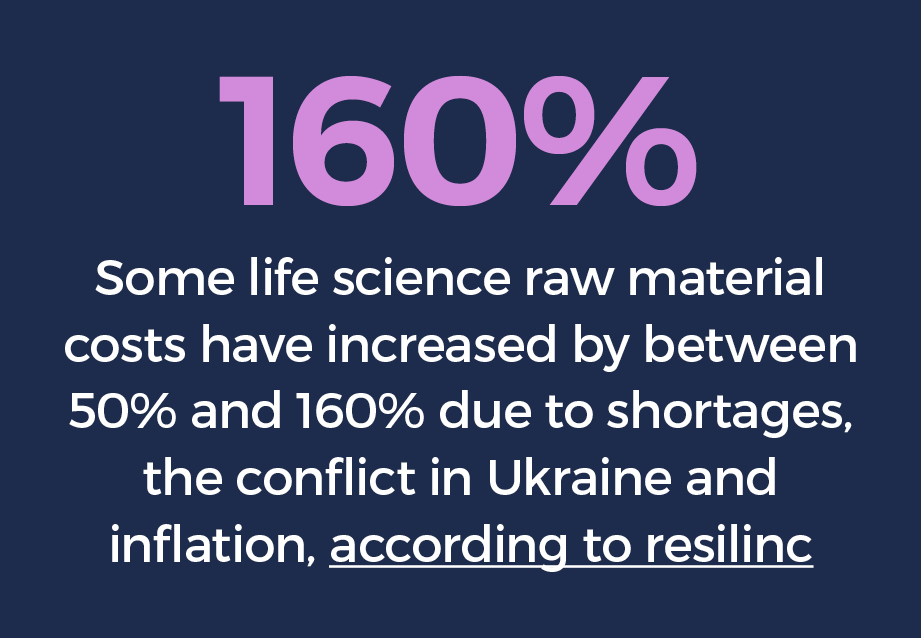International arbitration in 2024
Is your life sciences contract susceptible to renegotiation or termination if the economics of the deal changes?
By: Thomas W. Walsh, José Luis Prieto, Ruth Montiel
IN BRIEF
Disputes in the life sciences sector are evolving. Whereas many 2020-21 arbitrations arose from COVID-related supply chain disruptions, in 2022-23, inflation and increased costs of capital are driving continued high numbers of life sciences arbitrations.
Global macroeconomic factors are causing this shift in the nature of life sciences disputes, creating significant challenges for companies in the sector. High capital costs and ongoing inflation in the prices of materials and labor continue to put pressure on the economics of both products that are in development and products that have already been commercialized.
For products on the market, these increased costs often cannot be fully passed on to consumers, eroding margins and profitability. Companies attempting to develop and commercialize new products, in turn, are finding themselves in precarious financial situations as these market dynamics erode their budgets and cash balance. Indeed, in August 2023, the number of companies in the pharma industry reporting workforce reductions had already reached the total for 2022.
Increased costs and the resulting drop in prospective profits have caused a marked increase in the number of companies seeking to exit or renegotiate collaborations, supply agreements, and other contractual relationships that have become uneconomic in current market conditions. In many cases, these efforts precipitate arbitrations based on alleged breaches of the underlying contracts.
These market dynamics were a significant contributor to the rise in life sciences arbitrations in 2022-23, and we expect that they will continue to give rise to disputes in 2024. As we noted in last year’s report, most major arbitral institutions have reported significant growth in the number of life sciences cases they administer. These institutions continued to register high numbers in 2023.

Upheaval in the market, particularly around higher costs of capital, and inflation affecting raw materials and labor, has thrown many once-economic contractual relationships into jeopardy. We are seeing a marked rise in disputes in the life sciences space as companies reconsider the economics of collaborations, manufacture and supply agreements, and other agreements that were negotiated on cost assumptions that are no longer realistic.
Thomas W. Walsh
Freshfields Partner
Termination rights and dispute resolution
Implicated in many of these arbitrations are contractual provisions relating to termination rights and dispute resolution. These provisions often receive limited attention when the contract is negotiated, frequently due to the positive market outlook for the venture at that time. However, when a party is seeking to exit or renegotiate an unprofitable contract, these terms pose critical questions for both sides.
- Are there circumstances in which a party is permitted to terminate the agreement absent a material breach by the counterparty?
- Must the parties continue to perform while a dispute is resolved?
- Does the contract provide an efficient and predictable dispute resolution process?
- Will a dispute be confidential?
- Can a party claim lost profits if its counterparty breaches?
The answers to these questions will determine what kinds of losses a party can expect if it terminates or, in the inverse, what kinds of leverage the non-terminating party has to compel performance or obtain damages, including whether it is cost-effective for a party to initiate an arbitration to enforce contract terms.
Contract performance while an arbitration is pending
The framing of the contractual provisions that bear on these questions range widely, and companies should be cautious in thinking through their repercussions at all stages of the contractual relationship. For example, some contracts require parties to continue to perform while an arbitration is pending, through language such as: “The parties agree that, in the event of a dispute regarding performance under this contract, neither party may terminate this contract until final resolution of the dispute.”
While this type of provision may offer advantages in some situations, companies should be aware of the potential financial and opportunity costs of including these clauses in their contracts. For example, in the context of a supply contract, the party that wants to continue receiving and selling the supplied product will benefit from such a clause, and may consider it essential where shifting production to an alternative supplier could require months or years to obtain regulatory approvals. The party that does not want to supply, in contrast, could face substantial losses as the parties complete what can be a lengthy arbitration process.
Limitations of liability in life sciences
Limitations of liability clauses can likewise take center stage when a dispute emerges. Many contracts limit remedies, but the forms of these clauses range widely. A typical limitation of liability clause might limit consequential damages. Others explicitly prohibit recovery of lost profits. For example: “Neither party shall be liable for any indirect, incidental, special, punitive, or consequential damages, or any loss of profits.”
Such clauses are enforceable in many jurisdictions in most circumstances, including New York and Spain, and courts often interpret the phrase “or any loss of profits” to bar recovery of lost profits under the contract. Parties should think carefully before including such language in a contract. The exclusion of lost profits can significantly reduce the damages available under a contract and make it much less costly for a party to breach and exit a contract.
Hardship and change in circumstances
Contractual provisions regarding hardship and change in circumstances are also crucial in today’s volatile market. But in many cases, it is not only the phrasing of these provisions in the contract itself that will affect the parties’ ability to invoke them in order to exit or renegotiate. The choice of the contract’s governing law can also have a major impact on the enforceability of these provisions, as well as potential extra-contractual avenues for relief. For example, in some jurisdictions, such as Saudi Arabia, parties are expressly not permitted to contract around the right to rebalance a contract in the event of a dramatic change in circumstances. In other jurisdictions, such as New York or Spain, parties have more room to waive that right in their contracts.
To the extent possible, companies should consider these issues when drafting their contracts, rather than waiting until the market has shifted and/or a dispute has emerged. As market dynamics change, these choices can have significant repercussions whether a party is seeking to exit or renegotiate uneconomic contracts or hold its counterparty to their bargain.

It’s easy to look past termination and remedies clauses during negotiations, but companies should think carefully about these terms before entering into a contract. If a dispute does arise, these clauses can be decisive, materially affecting the parties’ leverage to either renegotiate, exit or enforce the contract. Companies should consider how best to position themselves in the event of a dispute, even at the early drafting stage.
José Luis Prieto
Freshfields Partner
Top trends 2024
- Introduction
- Generative AI: opportunities and risks in arbitration
- Arbitration in times of crisis: conflict, sanctions, climate
- Energy transition: critical minerals industry challenges
- Arbitration Act 1996 reforms: ensuring London remains a leading seat for international arbitration
- EU campaign to end intra-EU investor-State arbitration: pushing investor creativity
- India: a new era for international arbitration?
- The evolving landscape of arbitrator conflicts and disclosure requirements
- Construction and environmental disputes from oil and gas decommissioning
- Public international law’s growing relevance for businesses
- Clarity or confusion? The implications of domestic court rulings for arbitration
- Is your life sciences contract susceptible to renegotiation or termination if the economics of the deal changes?
- Arbitration top trends archive
Our team
-

José Luis Prieto Partner
Madrid
-

Thomas W. Walsh Partner
New York
-

Ruth Montiel Principal Associate
New York

